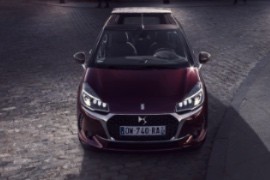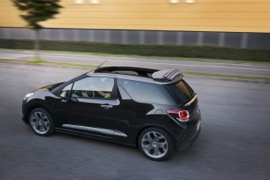DS AUTOMOBILES DS 3 Cabrio Models/Series Timeline, Specifications & Photos
First production year: 2013
Engines: Gasoline, Diesel
DS Automobiles evolved from a separate range of Citroen vehicles to a distinct brand in 2016, and one of its first products was the refreshed DS 3 and its open-top brother, the DS 3 Cabrio.
Citroen knew that if it wanted to get more money from its vehicles, it needed an upscale brand. As a result, it followed the same ideas that Hyundai had implemented with Genesis, at first as a model and then as a separate marque. The end result was the DS Automobiles, which was established in 2016. While these new carmaker products shared many underpinnings with other Citroen and Peugeot products, the design language, interior features, and amenities were utterly different. In addition, even the entry-level version, namely the DS 3, had some unique characteristics that made it desirable. In its open-top version, it competed against vehicles such as the MINI and the Fiat 500 Cabrio. However, the newly established French brand had a few aces up its sleeves to overtake the competition.
The 2016 DS 3 evolved from the former 2010 Citroen DS3 lineup. But, unlike that model and the facelifted version that followed in 2014, it didn’t sport the “double-chevron” badge on its front fascia. Instead, the DS logo took center stage on the front grille. Lower, on the apron, the automaker added a horizontal slat and a slim air intake. Customers could get the vehicle with round fog lamps surrounded by chromed surroundings, while the daytime running lights were integrated into the swept-back headlights.
From its profile, at first sight, nothing changed compared to its regular hatchback sibling. DS Automobiles continued the idea of creating a top cabriolet instead of a vehicle with a fully retractable roof. As a result, the B- and C-pillars remained in place, along with the side arches that connected the A-pillars to the rearmost ones. The roof, on the other hand, was made from a three-layer fabric and could retract behind the rear seats along with the rear window. The automaker also found an intelligent way to open the trunk regardless of whether the roof was up or down. Even though it was large enough to carry a few shopping bags, it featured a narrow access hatch. Customers could have the car with 16- or 17-inch alloy wheels, depending on the grade and options.
The cabin was revolutionized once again, even though the DS 3 went through a facelift in 2014. For the 2016 model year, it boasted a new touchscreen for the infotainment system that allowed Apple CarPlay connectivity and mirror Android phones. However, it wasn’t equipped with Android Auto. The flat-bottom steering wheel sported the DS badge in the middle, while in front of it was a three-circular instrument cluster, where the speedometer took center stage. It was flanked by the rev counter on the left and by an LCD display on its right. Depending on the trim level, the DS 3 Cabrio featured high-bolstered or regular seats at the front, while the rear bench seat could accommodate up to three passengers for short trips inside towns.
DS Automobiles inherited some of the engines and gearboxes produced by the Peugeot-Citroen Group for the rest of their ranges. As a result, it was available with a choice of diesel or gasoline powerplants paired with manual or automatic transmissions, depending on the version.
DS AUTOMOBILES DS 3 Cabrio 1.2L PureTech 5MT Start&Stop (110 HP)
DS AUTOMOBILES DS 3 Cabrio 1.2L PureTech 5MT Start&Stop (82 HP)
DS AUTOMOBILES DS 3 Cabrio 1.2L PureTech 6AT Start&Stop (110 HP)
DS AUTOMOBILES DS 3 Cabrio 1.2L PureTech 6MT Start&Stop (130 HP)
DS AUTOMOBILES DS 3 Cabrio 1.6L THP 6MT Start&Stop (165 HP)
DS AUTOMOBILES DS 3 Cabrio Performance 1.6L THP 6MT Start&Stop (206 HP)
Based on the same platform as the Citroen C3, the DS3 Cabriolet represented the French automaker’s comeback on the open-top vehicles that targeted premium customers.
Citroen introduced the DS3 hatchback in 2009 as an alternative for small-sized premium hatchbacks. Even though the brand itself wasn’t instantly recognized as an upscale automaker, the product itself was different than the rest of the French car manufacturer range. It was a clear upgrade compared with the Citroen C3, with which it shared its platform, and had some punchy engines that could give other hot hatches on the market a run for their money. That model gathered more than 200,000 units in sales in just three years despite the world financial crisis that shrunk the automotive market. As a result, Citroen dared to provide customers with an even more exciting version, the 2013 DS3 Cabrio.
With a front fascia shaped with organic lines and swept-back headlights, the DS 3 Cabrio introduced a new design language for the brand. The main grille was adorned by a chromed trim that included the “double-chevron” badge on its upper side. A set of round fog lamps flanked it, while vertical LED daytime running lights completed the front image of the vehicle with their side-mounted position.
On its profile, the DS3 Cabrio featured a floating-roof design. The automaker kept all the car’s pillars and installed a retractable canvas on the roof only. It was more of a top-cabriolet rather than a full one, which helped the DS keep the vehicle’s weight down. Citroen offered the DS3 Cabrio in a choice of seven body colors and three roof designs for a choice of fourteen combinations. Furthermore, customers could opt for the 16- or 17-inch alloy wheels. At the back, the three-dimensional-looking LED taillights flanked the tailgate. Unlike its regular hatchback sibling, the Cabrio featured a retractable rear window, so the trunk’s lid opened in an unusual, semi-circular way. Despite being large enough to fit a couple of suitcases, its access area was narrow.
Inside, the automaker tried to convince its customers with a cool cabin, where the driver fronted a tri-circular instrument cluster where the speedometer took center stage. On its left was the tachometer, while on the right was the dial for the fuel gauge, the odometer, and other info from the car’s onboard computer. On the center stack, the automaker placed the controls for the HVAC system and the stereo. Depending on the options, the center console housed the gear stick or the gear selector for the automatic transmission. In the back, the bench seat was wide enough to fit three adults on short jaunts, although on long travels, it was uncomfortable.
Under the hood, Citroen installed a wide choice of diesel and gasoline engines from the DS3 hatchback, including the potent 1.6-liter THP 155 PS (153 hp) gasoline powerplant paired with a six-speed manual. Selected versions were available with four- or five-speed automatic transmissions.

